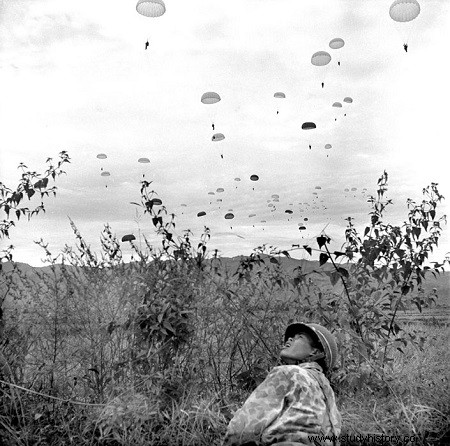
In the early days of the conflict, the main troop transport aircraft and liaison used by the French were German surpluses from World War II. Junkers Ju 52s and Fieseler Storchs fought in the fogs of North Vietnam or landed on hard-packed mud tracks in the delta, but they were later replaced by American aircraft including 100 Douglas C-47s in 1952 and 25 Fairchilds C-119 in 1954.
French parachute units in Indochina initially formed the 25th Div. airborne, but this organization proved unsatisfactory because many Para units were isolated or operated in remote areas. The reorganization introduced a military command of the parachute troops, comprising the French mainland forces, the paratroopers of the Foreign Legion and the colonial battalions of Vietnamese paratroopers who were in training in Saigon.
The first commander was Colonel Chavette, succeeded by Colonel de Bollardière and later by General Gilles who retained his command until the end of the Indochina War in 1954.
From 1947 to 1953, the 1st and 2nd Bns Para of the Foreign Legion and the 1st 2nd 3rd, 5', 6th and 8th Bns. Para colonials, an airborne armored force, support elements such as the 35th group of Aie. airborne, as well as Gn., were sent from France or formed and trained in the Far East. There was also a unit of the SAS type created and commanded by Colonel Langlais.
At the end of 1953, the French could field 16 Bns. Para, which together with support units made a total of 25,000 men.
The first operation of the war was a jump in September 1946 near Luang-Prabang in Laos which was then part of of the French colonial empire. It was followed by a drop near Haiphong to attack the Viet Minh forces north of the port.
In 1947 major operations took place between Bok Khan and Cao Bang; in 1948 in Viet Tri; in 1950 around Nam Dinh, while a year later two major drops took place at Nghialo and Hoa Binh, with two more in 1952 at Dong Hoi and Phu Doan on the Red River. The summit was reached in 1953 with jumps at Lang Son. Nasan, Than Hoa and Diên Biên Phû — there were two more airdrops at Diên Biên Phû between March and May 1954.
Imperialism in Asia occurred in the 19th century when European powers, Japan and the United States occupied Asian regions. The expansion to Asia was due to economic factors such as the guarantee of raw materials for industries, market for products and ideological factors such as civilizing these pe
